7-Eleven tops every c-store ranking chart when it comes to numbers, securing that spot with upward of 9,300 locations in the U.S. Look beyond store count charts, however, and the behemoth chain does not generally hold that coveted No. 1 spot.
The chain ranked No. 22 on Food and Wine’s list of “America’s Best Convenience Stores” (Buc-ee’s took the top spot, notably for its Texas barbecue, followed by Wawa with a nod to its hoagies). Another list, a Retailer Preference Index for the Convenience Store Chanel by customer data science company dunnhumby, didn’t rank 7-Eleven in the top tier either (QuikTrip, Wawa and Sheetz ranked as the top three, respectively). That index also noted that smaller regional chains tend to outperform national retailers in consumers’ views.
While “best” lists can be subjective in a way that numbers are not, don’t count 7-Eleven out on its aspirations to climb to the top of any list. The chain’s latest efforts could potentially bump it up a few notches on those foodservice lists—food is a featured element in 7-Eleven’s Evolution Stores. The stores represent an all-in effort to elevate all things 7-Eleven. No area was left untouched by the internal 7-Eleven team that remains laser-focused on mastering the learnings of these lab stores, with plans already in place to integrate elements system-wide throughout 2021.
The reimaging effort may prove the chain’s most prolific attempt to push the envelope of the iconic brand, both from an aesthetic and product category standpoint, with foodservice perhaps moving the farthest into a new realm for the chain.
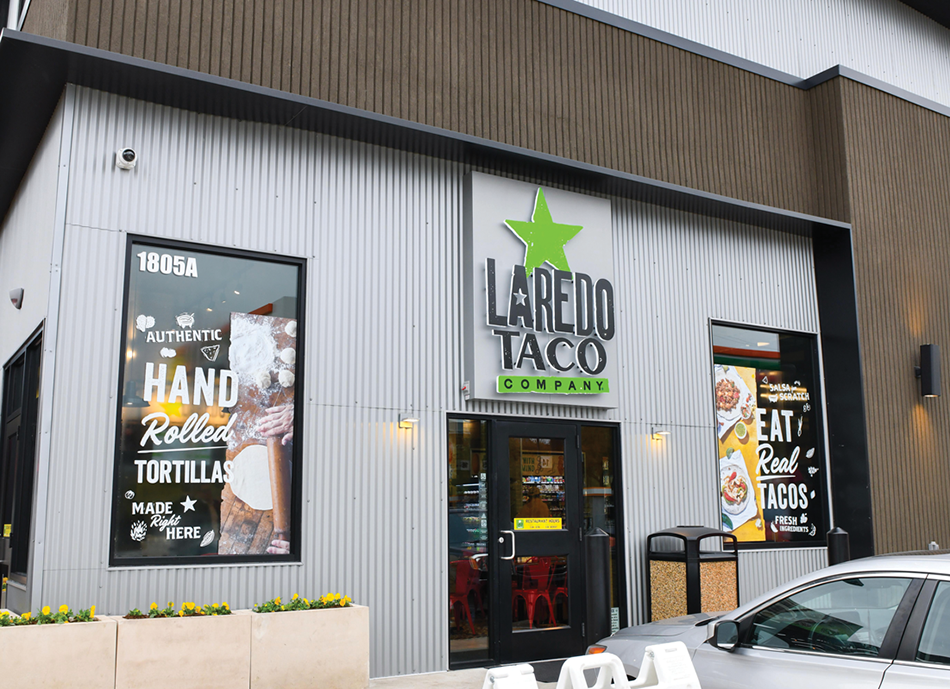
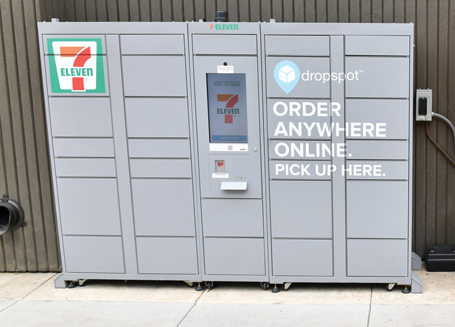 Clockwise from top: 7-Eleven continues its quest to innovate with new platforms at its lab stores since opening the first Evolution Store in Dallas in 2019. Pickup lockers remain in a test phase outside the Dallas Evolution store. The design and entry point for Laredo Taco Company intentionally creates distinction for the foodservice brand.
Clockwise from top: 7-Eleven continues its quest to innovate with new platforms at its lab stores since opening the first Evolution Store in Dallas in 2019. Pickup lockers remain in a test phase outside the Dallas Evolution store. The design and entry point for Laredo Taco Company intentionally creates distinction for the foodservice brand.
Try Everything
Four Evolution Stores have been built since 7-Eleven opened its first one in the chain’s home base of Dallas in March 2019. One year later, three additional Evolution Stores emerged: One in Washington, D.C., one in Manhattan and one in San Diego, all opening within a roughly three-month time frame between the end of February and the end of April.
So, what’s happened in that period between the first and latest opening? Well, a massive collection of observations and data based on consumer choices, for starters. 7-Eleven initiated its Evolution Stores as a place to test concepts and ideas, intentionally creating a retail living lab. An internal project team was tasked to explore a range of concepts, layouts and design elements, with the customer experience underscoring every effort. “It’s the totality of it all,” explained Chris Tanco, 7-Eleven’s executive vice president and chief operating officer. “I’m thrilled to see customers experience a much more contemporized 7-Eleven.”
Contemporized fits as a description both aesthetically and operationally. Design elements are universally sleek and modern throughout every area of all four lab stores. From flooring to wall coverings to fixtures to new offerings, nothing was overlooked, right down to details like the door handles on the cold vault. The longer-than-normal, elegant stainless-steel door pulls on the reach-in coolers are something more akin to a high-end café in a five-star hotel. An immense number of those kinds of small upgrades exist, which all add up to something unexpected for customers when they enter the store.
“People are shocked that it’s a 7-Eleven,” said Molly Long, vice president of store evolution and design. “It’s been really exciting to see the customer reaction. We are hitting the most important goal: not alienating the people already coming into our stores. We want them to still feel like it’s a place for them.” Her comment emphasizes the efforts in place to determine just how far 7-Eleven can move the needle and draw in a new customer base—namely millennials—while retaining regulars.
The expansive exploratory mission goes beyond aesthetics to scrutinize areas that can become more operator-friendly. For instance, gondolas with pullout shelves to speed restocking and auditing efforts and adjustable shelves in the cold vault.
Myriad concepts address potential consumer interest in different areas, such as whether consumers are receptive to buying high-end electronics at 7-Eleven, or if shoppers would visit a 7-Eleven to fill a growler with local craft beer. Each Evolution Store comes with its own variables, allowing the internal team to home in on exactly what customers prefer. Another example: Do customers want to serve themselves a cold brew coffee from a self-serve tap system or would they prefer a staff pour? Both service models are in test at different Evolution Stores.
The premise of the Evolution Stores has always been to churn out new platforms, take the ones customers love, inject them into the larger 7-Eleven system and proliferate them going forward as store standards, explained Tanco. “We are testing multiple different platforms, designs and concepts,” he said. “We want to get them to the place where we can scale them and integrate them as a store standard.”
Elevating to QSR and FSR Status
While each Evolution Store includes an abundance of unique elements, 7-Eleven’s approach to foodservice with its Laredo Taco Company (LTC) and Raise the Roost brands offers a glimpse of its foodservice intentions. “We want these both to be stand-alone brands under the 7-Eleven halo,” said Brad Williams, senior vice president of corporate operations and restaurant platforms at 7-Eleven.
Williams conceded that the full-service, made-to-order formula built into LTC is not a concept that can easily fit into 7-Eleven’s existing store base; the franchise network largely consists of smaller stores that lack the space to execute the LTC model. Raise the Roost, however, has greater potential as a fit with the bulk of existing franchisees, he said.
Raise the Roost offers chicken sandwiches, chicken tenders and bone-in and boneless wings. The Southern-inspired fried chicken and biscuit concept originally launched in 2017 under a different name. Today, branding elements place the emphasis on made-from-scratch, hand-breaded items and homemade propriety sauces. Another key component of the concept connects to transparency, which 7-Eleven hopes will translate with customers as they watch staff prepare the chicken in fryers behind the counter. “It gives us more credibility with the customer to have things made on-site,” noted Williams. “We want to move as many of the elements of preparing fresh food as front and center as possible.”
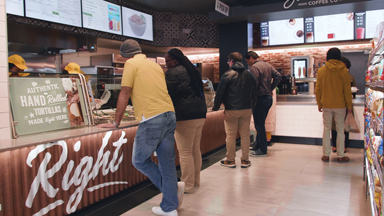
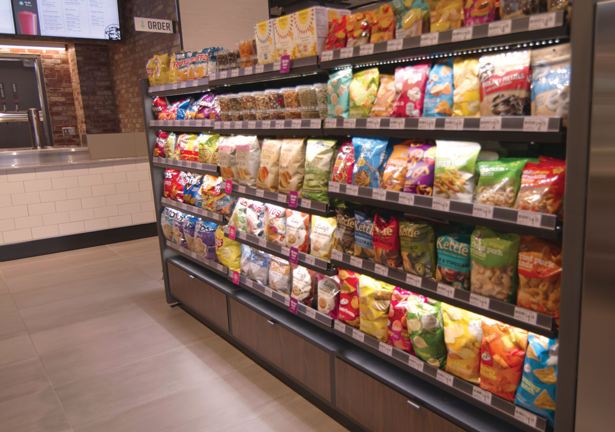 Laredo Taco Company operates in three of the four Evolution Stores. Every fixture and merchandising element was scrutinized for each Evolution Store, with the intent to improve functionality—think gondolas with pullout shelves for restocking ease—as well as upgraded design elements.
Laredo Taco Company operates in three of the four Evolution Stores. Every fixture and merchandising element was scrutinized for each Evolution Store, with the intent to improve functionality—think gondolas with pullout shelves for restocking ease—as well as upgraded design elements.
Looking at larger industry-wide trends, transparency and daypart are working in 7-Eleven’s favor with both Raise the Roost and LTC. The desire among consumers for a sense of transparency existed before COVID-19 but certainly became acutely more important with COVID-19, noted Tanco. Add to that a dip in breakfast business that similarly left many c-stores with a void in the morning daypart as the coronavirus shifted shopping patterns. Given the primary lunch and dinner daypart focus of Raise the Roost and LTC, 7-Eleven’s emphasis on these two food concepts comes at an opportune time, he said.
Manhattan is the only Evolution Store with a Raise the Roost concept to date, while LTC operates in the three other Evolution Stores. In total, 7-Eleven operates more than 15 Raise the Roost concepts, the bulk of which are in corporate stores. Two of those stores, one in South Carolina and the other in Virginia, operate with an expanded menu with a larger platform that includes a made-to-order option.
The Manhattan Raise the Roost focuses on a grab-and-go model. The reduced-size version has tested really well, said Tanco. “The goal is to craft it so it’s an easier platform for franchisees,” he added. “We continue to fine-tune it.”
I’m thrilled to see customers experience a much more contemporized 7-Eleven.
Raise the Roost has the potential to complement the more operating intense, full-service LTC. However, Tanco remained noncommittal about how the formula will bear out in the future. “Whether we put both in a store is yet to be decided,” he said.
It does not take a huge leap to speculate that large facilities, such as high-traffic highway stores, may provide the kind of real estate and customer flow that could support two different food concepts paired with a 7-Eleven. Notably, the company inherited just that kind of location with its acquisition of more than 1,000 Sunoco stores in 2018. Sunoco had built up a strong travel center presence across the U.S. That same acquisition also brought 7-Eleven Laredo Taco Company, which originated in 2006 as a proprietary brand of Stripes Convenience Stores.
Industry observers who follow merger-and-acquisition activity closely will recall that the Sunoco deal was complicated and included Federal Trade Commission-mandated divestitures. As a result, additional Laredo Taco Company stores continue to operate independent of 7-Eleven. Add to that count the 500-plus 7-Eleven Laredo Taco Company sites, all of which operate as corporate stores. None of this is evident to consumers, of course. The connection to any c-store merely appears as a notation on LTC’s website: “Find us at your local 7-Eleven or Stripes stores.”
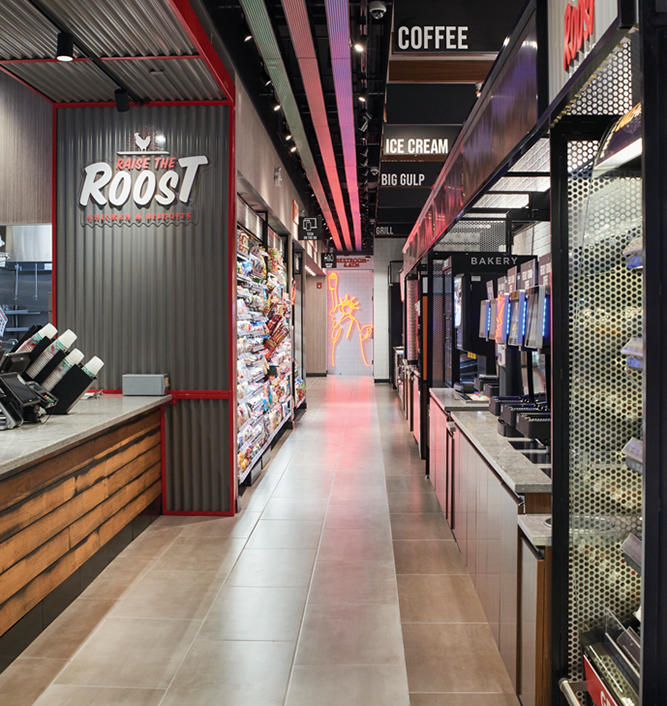
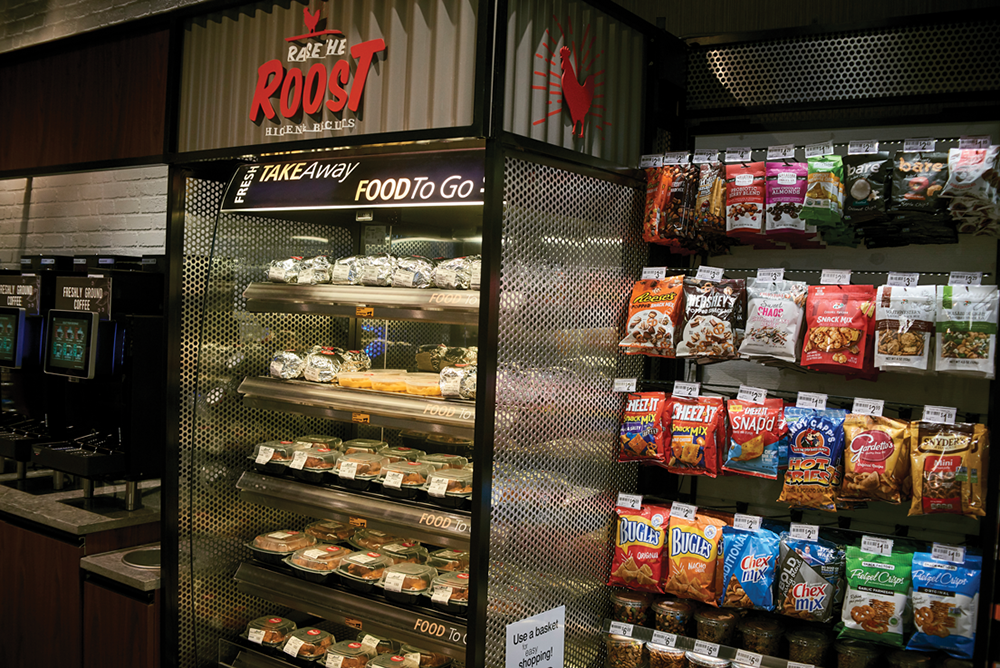 Laredo Taco Company operates in three of the four Evolution Stores. Every fixture and merchandising element was scrutinized for each Evolution Store, with the intent to improve functionality—think gondolas with pullout shelves for restocking ease—as well as upgraded design elements.
Laredo Taco Company operates in three of the four Evolution Stores. Every fixture and merchandising element was scrutinized for each Evolution Store, with the intent to improve functionality—think gondolas with pullout shelves for restocking ease—as well as upgraded design elements.
Full Speed Ahead for Laredo Taco Co.
LTC, with its full-service, made-to-order model, sits on the opposite end of the foodservice spectrum than Raise the Roost. Known for its handmade tacos and street-style Mexican food, LTC menu items range from breakfast tacos to traditional plates such as the Mexican Plate that includes two enchiladas, two tamales, beans and rice; and even family meals with enough food to feed six people.
7-Eleven deserves credit for elevating the LTC brand with the integration of its Evolution Store concept. “It was a very fortunate timing of events,” said Long, noting that LTC came into the mix in the early stages of development of the Evolution Store. “With the lab, we wanted to make LTC feel like its own restaurant inside,” she said. Prior to that, she described some of the LTC locations in South Texas as being a little more shoehorned into the c-store.
Un-shoehorning the concept offers an appropriate metaphor to describe 7-Eleven’s approach with LTC. This is as close to a stand-alone unit as possible while still sharing four walls. From the outside, consumers may not even connect LTC as a 7-Eleven brand. The design positions it much like a co-branded property, complete with two entrances, and reflects what consumers widely already accept today with brands like McDonald’s and Taco Bell.
We want to move as many of the elements of preparing fresh food as front and center as possible.
That distinction helps define the Mexican QSR as its own brand versus a proprietary offering, and some might argue it could develop that way, perhaps at some point devoid of a 7-Eleven store altogether. The evidence mounts when considering that Joe DePinto, 7-Eleven’s president and CEO, maintains a direct link to two casual-dining brands as chairman of the board for Brinker International, which owns Chili’s Grill & Bar and Maggiano’s Little Italy.
The larger 7-Eleven growth model has altered a bit with LTC in the mix, namely in terms of both the preferred size and location of potential market areas. “We’re looking for sites that will be great for a c-store, restaurant and fuel—that trifecta,” said Williams. For a store-plus-restaurant location that means 4,650 square feet, he noted, with the potential for a footprint as large as 6,800 square feet for a store that would include on-premises dining. One of the ways 7-Eleven tests viability of LTC in a market is through food trucks, which offer a trial in the community to see if they embrace the concept.
Laredo Taco Company and Evolution Stores are both on parallel paths in terms of growth, explained Williams. “Both are moving fast,” he said, with new stores and retrofits prime opportunities. By the end of 2020, 7-Eleven will add another 75 LTC locations to the mix and plans to open 100 more in 2021. In addition, 7-Eleven plans to open approximately 10 more Evolution Stores in 2021.
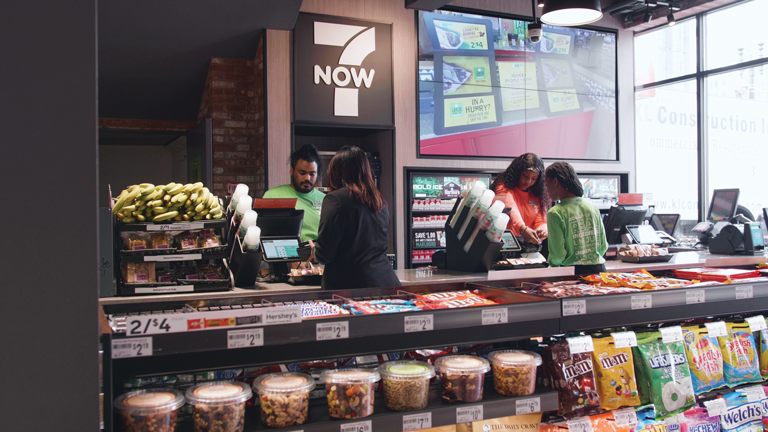 7-Eleven continues to fine-tune its digital package with the goal of offering a touchless, contactless checkout experience.
7-Eleven continues to fine-tune its digital package with the goal of offering a touchless, contactless checkout experience.
Moving Toward 2.0
Not to go unnoticed, 7-Eleven remains in the midst of a 2.0 prototype that springboards off the Evolution Store design with the intent to land squarely in the franchise and new-build space. Executives are gearing up to launch its 2.0 prototype that Long anticipated will happen toward the end of the second quarter of 2021. That will start the clock ticking on building new stores with that design, she said, although she added that it could take a full year before a new store opens with the 2.0 design footprint.
“We will see hints of 2.0 as we remodel stores in 2021, and it will impact certain new builds in the pipeline,” said Long. “I can truly say I’ve never been more bullish as a large company truly transforming ourselves. It’s hard to change so many stores. We let that be a roadblock for a while, but we cannot let the existing store base be a reason we cannot evolve.”
It’s a lot to take in, for customers, the 7-Eleven corporate team and franchisees alike. If Long, Williams and Tanco reflect the views of everyone at 7-Eleven, there is a clear, unified outlook for the future. Here’s how those three summed things up: The experience is the North Star (Evolution Stores), from there the work transitions to standardizing the vision and making it scalable (2.0 prototype). Add in a remodel package to impact existing stores and, if the team can pull all of that off, they may just get what they are after: Draw in a new group of customers while retaining the original core base, and, perhaps, even a top spot on a best neighborhood food chart.
Photo Gallery
Click on an image to view the gallery.